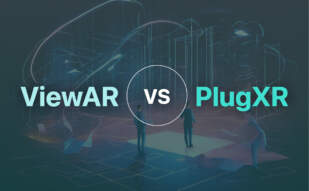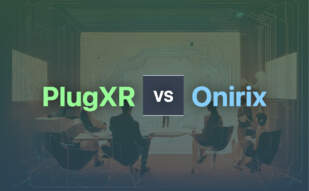PlugXR is a cloud-based platform that enables the creation of 3D, AR, VR & Spatial Computing solutions without the need for app downloads. It has been implemented in various industries and offers features like advanced reporting, cross SDK capabilities, and WebAR projection, driving consumer impact and business growth. The latest V5.0 version includes a Cloud Editor and Templates for easier creation of immersive experiences.

For those exploring alternatives to PlugXR, options to consider are Aircada, ZapWorks, EasyAR, 8th Wall, ViewAR, UniteAR, BUNDLAR, Wikitude, Vuforia, Blippar, Onirix, XR+, Gravity Jack, Camera IQ, and Augment.
Aircada

With its roots firmly planted in 2020 by the brother duo, Sean and Wylie Chenoweth, Aircada vows to revolutionize the realm of Augmented Reality content creation. It’s not just another AR platform, but a confluence of mundanity and miraculous, engineered to cater to users of all spectrums, from businesses of all sizes to individual AR enthusiasts.
Aircada Top Features
- State-of-the-art Spatial AI that accelerates AR creation with AI-driven algorithms, establishing a middle ground between simplicity and precision.
- An integrated AR content management system for swift and streamlined operations.
- Device agnostic platform, compatible with mobiles, tablets, and lidar-equipped gadgets, upholding a democratic digital ecosystem with multi-device deployment, from AR and VR headsets to android and iOS mobile phones.
- Advanced 3D model scanning & uploading capabilities with realistic 3D rendering and geometry occlusion management.
- WebGPU usage for lightning-fast performance and seamless web interface integration.
- Multiple language support catering to a global audience base.
- Diligent security with encrypted communication, putting data privacy at the fore.
| Feature | Description |
|---|---|
| Swift AR Creation | Produces AR experiences in mere seconds, championing efficiency. |
| Collaboration | Allows for easy team collaboration, fostering democratic creativity. |
| Continuous Upgradation | Committed to regular feature updates for staying ahead of the digital curve. |
Aircada Downsides
- Being relatively new in the market, Aircada may have fewer integrated features compared to more seasoned competitors.
- The platform’s heavy focus on simplicity may not cater to some experts looking for more complex functionalities.
Aircada Pricing
With affordability at heart, Aircada is flush with a FREE edition that’s evocative of unrivaled competitiveness. Beyond this, the pricing escalates to accommodate more complex needs, starting from $20 a month to an elaborate enterprise plan at around $79+ per month.
Aircada Use Cases
Use case 1 – Marketers
Aircada revolutionizes marketing techniques by offering engaging AR content creation tools, helping to create unique and interactive advertorial experiences that can captivate audiences and boost brand recognition.
Use case 2 – Artists and 3D Designers
Thanks to its powerful 3D model scanning & uploading capabilities, artists and 3D designers can give life to their creations like never before, adding a new dimension to their creative processes.
Use case 3 – OEMs and Industrial Equipment
Aircada improves the functionality of OEMs and industrial equipment by offering guided AR procedures and training, facilitating more effective and efficient operations in the industrial field.
ZapWorks
An embodiment of a comprehensive AR ecosystem, ZapWorks offers a creative suite constituted of designer tools, studio, and AR SDKs. It is a platform that empowers designers, developers, and marketers alike to create seamless WebAR experiences via no-code, low-code, or custom code options.
ZapWorks Top Features
- ZapWorks Designer: An intuitive, drag and drop tool that requires no apps, downloads or coding to create stand-out WebAR experiences.
- ZapWorks Studio: Facilitates AR content creation by integrating the simplicity of a visual UI with the versatility of a code editor.
- Tracking Types: Includes world, image, and face tracking. The former aids product visualisations and more, while image tracking overlays digital content on products and print.
- Enterprise-scale Deployment: Enables branding, hosting, prioritised support, security and more for large projects.
| Feature | Details |
|---|---|
| ZapWorks Studio 6 | Latest offering, designed to lower the technical barrier in creating interactive short-form mobile content. |
| Integration | Allows importing 3D models, characters, scenes from Sketchfab, and is synced with ARKit & ARCore. |
| Face Tracking | A robust tool that tracks multiple faces and generates 3D mesh for realistic, feature-rich facial animations. |
ZapWorks Limitations
- User experience (UX) might not be optimal and some users have reported limited creative freedom.
- Restrictions on industry standard formats may pose challenges.
- Some features, such as world tracking and cylindrical tracking for WebAR, are reportedly limited.
ZapWorks Pricing
Prices vary based on the nature of use—personal, business, or educational. For app embedding, additional costs may apply. The specifics aren’t detailed, but it’s clear that it isn’t an open source platform.
ZapWorks Use Cases
Education
The ZapWorks toolset transforms classroom learning & training programs, making them more interactive and engaging.
Marketing and Sales
Top brands leverage it to prototype products, drive innovation and enhance their sales & marketing strategies.
Tech Competition
ZapWorks hosts competitions like the Zapworks Hackathon which not only promotes creativity, but also contributes to AR community expansion.
Onirix

Onirix, based in Spain, is a front-runner in the augmented reality (AR) content creation and publishing service arena. The platform impressively incorporates videos, 3D models, audio files and more, offering a comprehensive toolset to its user base. Onirix efficiently supplements user interaction via transition between numerous elements enabled by its platform.
Onirix Top Features
- WebAR player for effortless content sharing across digital platforms
- Facilities for professional user interaction and transitioning between multiple elements
- Incorporation of varied content types such as videos, 3D models, and audio files
- Direct AR visualization in the web browser, no app installation required
- Unique Experience Editor designed specifically for non-technical users
| Integration Mentioning | Target Audience |
|---|---|
| Unity via SDK for iOS device permission management | Developers and professionals in graphic design, IT services, software firms, program development |
| Specialty Areas | Competing Solutions |
Onirix Limitations
- Lack of ‘pay as you go’ license model for projects on pause
- Pricing could be steep for smaller companies
Onirix Pricing
Pricing for Onirix starts from €89 per month, with a free version and trial availability.
Onirix Use Cases
Use case 1: AR service UX improvement
Onirix offers an intuitive platform that enhances AR service user experience (UX).
Use case 2: Broad range of sectors
Its tools have been effectively used by a diverse range of sectors, including nonprofits, graphic design, IT services, software firms, program development.
Use case 3: Engaging content creation
With the facility to incorporate various elements such as videos, 3D models, and audio files, it empowers even non-technical users to create engaging AR content.
XR+
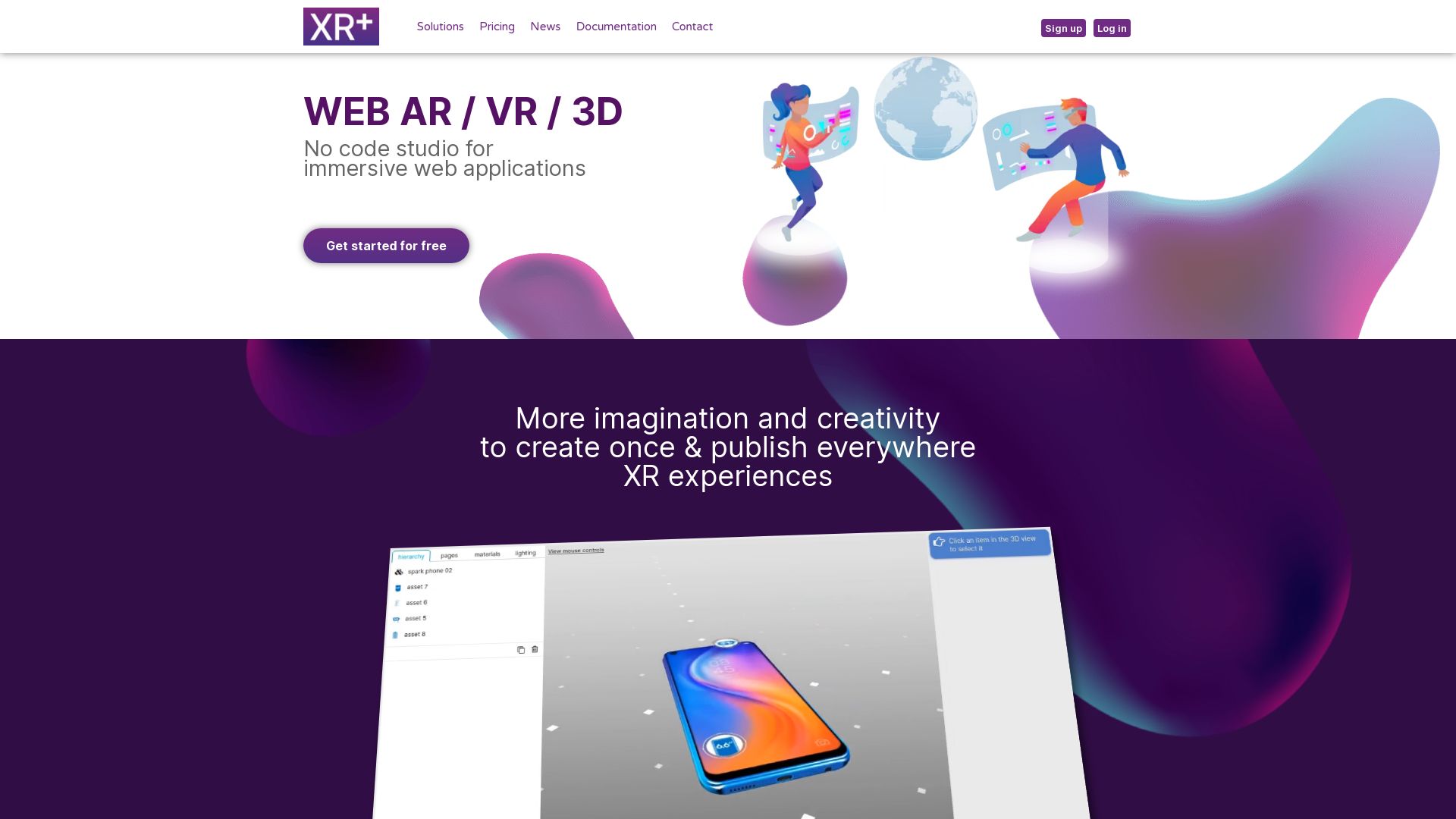
Unveiling a new era in the realm of immersive technology, XR+ offers dignified specialties in the field of web AR/VR/metaverse. With its no-code creative tools, they enthrall with advanced, immersive storytelling that unveils limitless applications across multiple sectors, including tourism, heritage, culture, and more.
XR+ Top Features
- Inclusive: Offers features tailored for users with disabilities, including subtitles, audio descriptions, and translations.
- Eco-responsible: Encourages AR for product testing before purchase, effectively aiding in reducing product returns.
- AI Integration: Harnesses AI for automatic video creation, making use of photorealistic or 3D character generation.
- Custom Development: Prioritizes user-specific needs, allowing custom development tailored to unique experiences.
| Feature | Explanation |
|---|---|
| MDACA XR+ | An integration component of the MDACA platform merges near-real-time data with VR/AR for innovative data visualization and training. |
| AR Filters | Enhances the online communication experience with computer-generated effects layered over real-life images. |
XR+ Limitations
- While XR+ provides a comprehensive package, it doesn’t mention a specific solution for advanced analytics support.
- Even though XR+ strongly supports custom development, another focused development tool might be necessary for highly complex experiences.
XR+ Pricing
XR+ offers a range of pricing options, from a free version to advanced and super XR web apps, each offering varying features and support levels. For specific pricing details, users are advised to visit the XR+ website or contact their sales department directly.
XR+ Use Cases
Use case 1: Tourism
In the industry of tourism, XR+ comes to life, offering immersive experiences that teleport users to new destinations. Its AR capabilities can enrich the understanding and appreciation of cultural heritage sites, enhancing the touristic experience.
Use case 2: Marketing and E-commerce
Through VR and AR, XR+ elevates marketing and e-commerce strategies. It aids in creating immersive games and interactive catalogs for improved product testing, thus potentially reducing the rate of product returns.
Use case 3: Education and Training
By integrating data across multiple sources in real-time, XR+ offers an innovative approach to education and training. It combines AI, Machine Learning, and AR to support intricate data set analysis and knowledge transfer learning quantification.
Gravity Jack
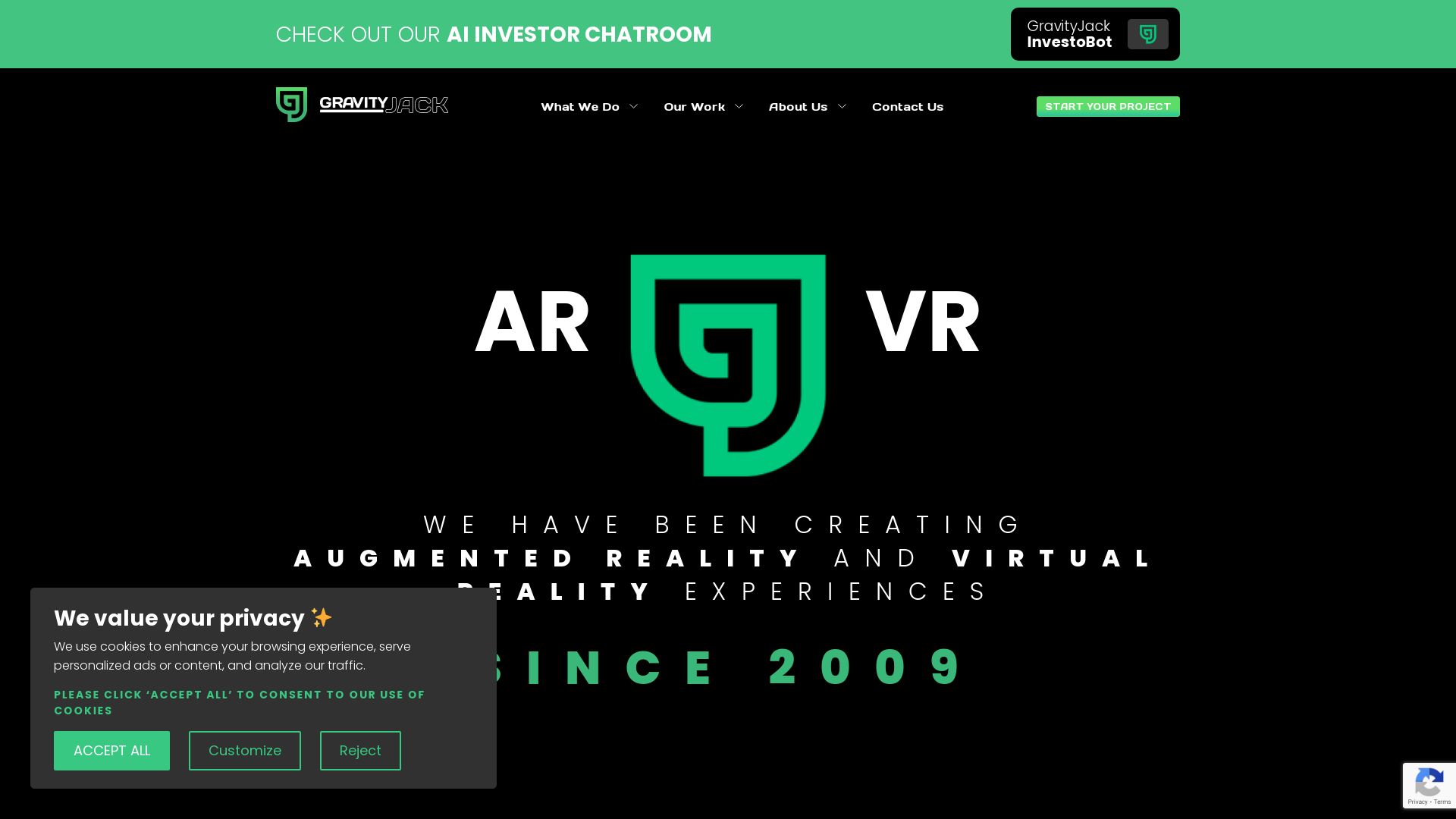
Founded in 2009, Gravity Jack is one of the oldest firms in the augmented reality tech industry in the US. With 300+ clients across diverse sectors, Gravity Jack is slated to be a game changer backed by seven patents in AR and computer vision.
Gravity Jack Top Features
- Pioneered in object detection using machine learning
- Developers of famous apps such as ‘Skydive 360’ and a platform like Double Down Casino.
- A service model that emphasizes client-partnerships
- An upcoming AR game, ‘War Tribe of Binyamin’, integrating AR and AI
- Facilitates crowdsourced machine learning datasets for translating all world languages.
| Unique Selling Proposition | Details |
|---|---|
| Global connectivity | Connects users across the globe through gameplay, and links underserved communities to the global economy. |
| Revenue Share | Intends to distribute 10% of the game’s revenue (after App Store fees) as dividends, derived from expected in-game revenue. |
| Clientele | Served prominent organizations like Mitsubishi, Toyota, NASA, Intel, Ford, Dell, Samsung, Lockheed Martin, Department of Defense, etc. |
Gravity Jack Downsides
- Faced major tech hurdles in earlier stages due to the lack of AR glasses and smartphones in the market.
- Required a return investment from a global tech giant earlier, indicating potential funding issues.
- Pre-determined dividends, tied to game performance, may not align with investors’ expectations.
Gravity Jack Pricing
As a shareholder-driven company, shares can be purchased at $3.92 with an overall company valuation at $22.78M. The minimum investment stands at $348.88, while the maximum is capped at $1,234,999.92.
Gravity Jack Use Cases
Use case 1
For automotive manufacturers like Mitsubishi and Toyota, Gravity Jack’s AR technologies could be used in concept vehicle design, demonstrations and training.
Use case 2
In the gaming industry, Gravity Jack’s upcoming AR-integrated releases could be a major draw for game developers and enthusiasts.
Use case 3
Gravity Jack finds significance in the defense sector as well; AR can facilitate advanced training modules, simulations, and even aid in operations.
Camera IQ
Welcome to the orb of Camera IQ, a luminary platform in the arena of Augmented Reality. This versatile tool offers AR effects within TikTok’s famed Effect House while also allowing the creation of templated AR experience across various social media platforms. It’s a game-changer that aims to enhance brand engagement and streamline AR creation.
Camera IQ’s Top Features
- AR effects: Camera IQ bolsters brand engagement with its stunning AR effects.
- Analytics: Proprietary analytics track performance and the virality of AR experiences.
- 3D tools and real-time previews: These features simplify the complexity of AR creation.
| Feature | Benefit |
|---|---|
| Augmented Reality Service (ARS) | Drives 5G adoption |
| Integration | Ratings/Reviews available for enterprise and developers |
| Interactive Shopping Experience | Drives virtual product try-ons in retail |
Camera IQ Downsides
- Pricing might exclude smaller businesses or startups
- Platform has a steep learning curve
Camera IQ Pricing
While specific pricing details are not disclosed, it is pertinent to note that Camera IQ has taken significant strides in sales, marketing, and product development thanks to its substantial funding. The platform is primed for businesses of various sizes.
Camera IQ Use Cases
Use Case 1 – Boosting Brand Engagement
Camera IQ is a tool of choice for brands aiming to enhance their customer interaction and engagement. With its powerful AR effects, brands can deliver immersive experiences that drive engagement rates sky high. The Cartoon Network’s ‘Garnet Glasses’ effect, for instance, received over 4 million views and 14,000 fan posts.
Use Case 2 – Improving Conversion Rates
In the dazzling world of retail, Camera IQ steps in as a wizard, translating products into camera and augmenting interactive shopping experiences. The results? A potential increase in conversion rates by an astonishing 250%!
Use Case 3 – Simplifying AR Creation
For businesses and developers aiming to harness the magic of AR without getting entangled in its complexities, Camera IQ offers a lifeline. With its 3D tools and real-time previews, AR creation is a simplified affair.
Augment

Offering a rebellious boost to real-world engagement, Augment serves up digitally enhanced visual, auditory, and sensory stimuli to elevate users’ experience of the environment around them. This audacious Augmented Reality (AR) company harnesses innovative tech to overlay computer-generated images onto reality, blending the physical with the digital.
Augment Top Features
- Smart, accessible insights through highlighted features in the physical world.
- Facilitates unique user data collection with marketing campaigns, and product/service promotions.
- Breaks boundaries by blending a real-world environment with overlaid perceptual information.
- Offers two types of AR – Marker-based and Marker-less, offering variety in image and information display.
- Creates an interactive user experience, not just replacing it, as VR does.
| AR Use | Benefits |
| Mobile computing | Allows greater accessibility and flexibility for users. |
| Retail | Increase in brand awareness and sales due to interactive experiences. |
| Healthcare and Education | Enhanced learning and comprehension from digital overlays on real-life environments. |
Augment Downsides
- No mention of a specific category of devices/smartphones supported by Augment.
- The marker-based AR type might be limiting depending on the user’s environment and needs.
Augment Use Cases
For Retail
Augment makes products pop off the page, bridging the digital/physical divide to invigorate product presentation and drive sales. As part of a cutting-edge industry 4.0 ecosystem, this tool is revolutionizing retail.
For Healthcare
AR, in the hands of Augment, acts as a window into the complexities of the body, facilitating advanced medical training. It’s AR reimagining and redefining healthcare for the digital age.
For Education
Say goodbye to snooze-worthy lectures. Augment brings learning to life with vibrant, interactive AR experiences that captivate students and enhance educational outcomes. That’s schooling re-imagined for the 21st century.
EasyAR
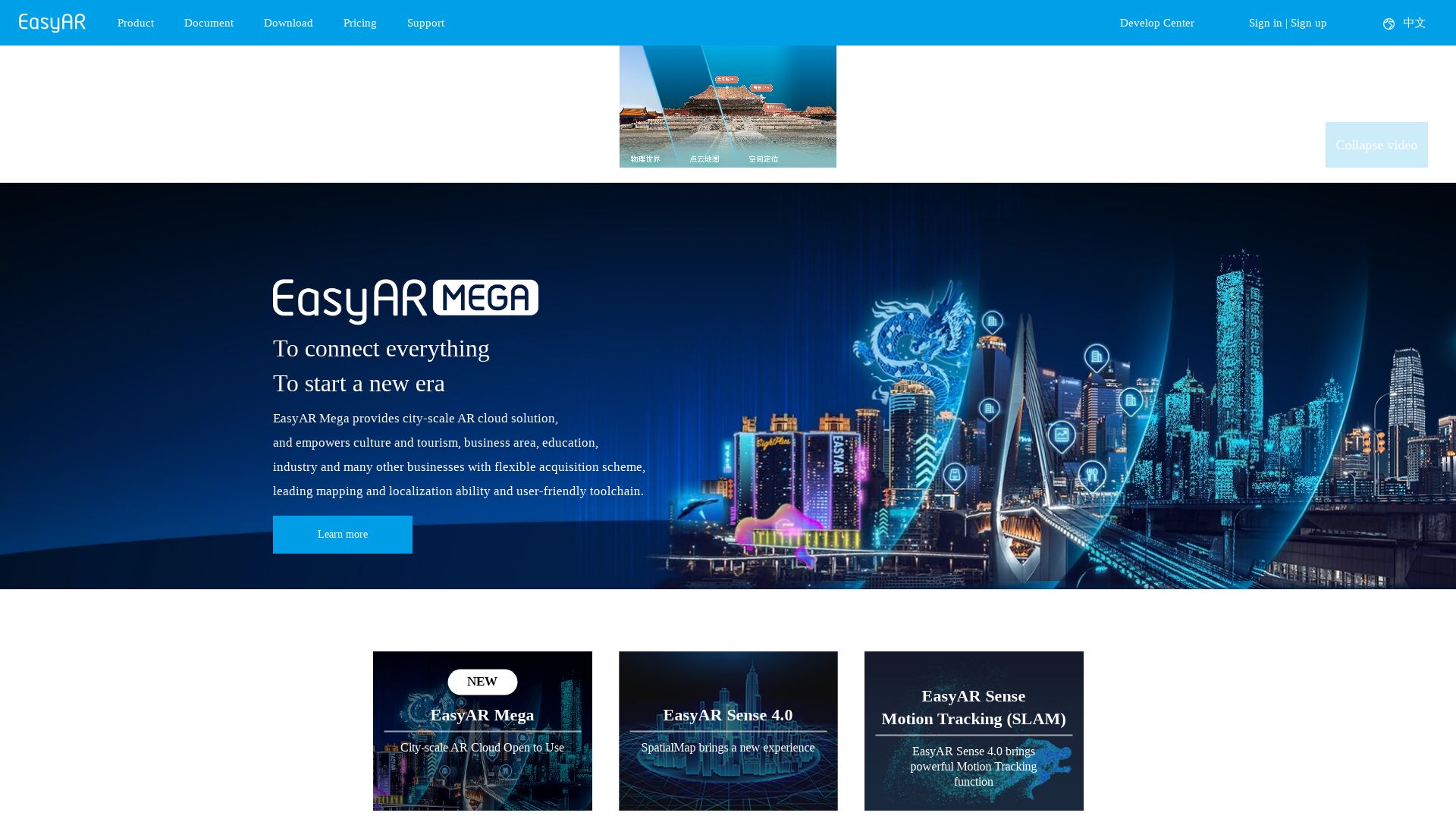
With its origins rooted in China since 2012, EasyAR occupies a prominent space in the Augmented Reality (AR) landscape, notably for AR application development and digital animations. It brings together a suite of features, such as relocalization, persistent AR content, and easy access, all the while utilizing both local & cloud-based solutions and a single RGB camera for capturing spatial information in the physical environment.
EasyAR Top Features
- Cross-platform development support (iOS, Android, Windows, macOS)
- EasyAR SDK – a tool providing developers with the leeway to build interactive AR apps
- SenseMARS software platform offering functionalities like AI-enabled AR and MR content generation, decision intelligence, and perception intelligence
- Automatic dynamic lighting and reflections featuring AR Occlusion
- High-precision 3D physical world models through SenseMARS Reconstruction
- The new EasyAR Mega – a city-scale AR cloud solution with a user-friendly toolchain and SLAM framework
| Feature | Description |
|---|---|
| Auto-generated Avatars | Enables the creation of digital identities or avatars from photos intended for Metaverse, strengthening the user interaction |
| No coding AR app development | Simplifies the AR app development process with no requisite for coding, accelerating content creation |
| AR Configurator, AR Measurement, AR Floor Tiling | Caters to various AR applications and user experiences enriching the software diversity |
EasyAR Limitations
- Unfeasible pricing for some users
- Lack of optimization
- Limited web support
EasyAR Pricing
With a free trial available, EasyAR proposes a monthly price of $39, providing a reasonable gateway to its powerful AR toolset.
EasyAR Use Cases
Educational effectiveness
EasyAR finds significant use in the education sector, enhancing learning experiences by enabling interactive and realistic content.
Business applications
Companies can leverage EasyAR to create AR-based advertisements, product previews, and immersive experiences that capture customer interest.
City-scale mapping in tourism
With EasyAR Mega’s city-scale AR mapping, local and global tourists can access practical and engaging guides to enhance their journey.
8th Wall

Founded in Palo Alto, 8th Wall is an award-winning AR developer platform striving to democratize augmented reality (AR) access. With a robust WebAR technology stack, it enables interactive AR experiences on any smartphone, with no app required, reaching over 5 billion devices globally. Its influence spans several industries, powering 2,000+ commercial experiences just in its first year.
8th Wall Top Features
- 6-DoF Tracking, Lighting and Surface Estimation.
- Image Target Tracking for both Flat and Curved surfaces.
- Face Effects: Enhanced tracking, improved filters, iris tracking, multi-face support.
- AR-centric tools: 8th Wall AR Engine and Cloud Editor.
- AR Code: Uses AR QR Codes for anchoring and accessing AR content.
| Feature | Description |
|---|---|
| Cloud Editor | A cloud-based integrated development environment for WebAR and WebVR development offering integrated source control, commit history, live previewing, wireless remote debugging and push-button publishing. |
| SLAM | Simultaneous Location and Mapping system, introducing WebAR in 2018 for accurately integrating with viewer’s surroundings. |
| Sky Effects | Recognises and segments out the sky, turning it into a creative space for AR content. |
8th Wall Limitations
- Requires understanding of complex web technologies like JavaScript, WebGL and HTML5.
- Cost for commercial license can exceed 2000 USD per month.
- Relies solely on webAR technology, lacking compatibility with hardware like Apple’s Vision Pro Headset.
- Limited tutorials and community support compared to competitors.
8th Wall Pricing
Note that 8th Wall’s commercial license can exceed 2000 USD per month. Exact pricing details are not provided.
8th Wall Use Cases
Use case 1: Retail
8th Wall’s new WebAR feature introduces hand tracking, ideal for retail applications like fitting virtual jewellery on customers’ hands, fingers and wrists.
Use case 2: Gaming and Education
The platform’s hand tracking extends use in gaming and education sectors, enabling greater interactivity with virtual objects.
Use case 3: Content Customisation
New customisation tools have been introduced for a tailored WebAR experience, optimised for the specific needs of creators and developers.
ViewAR

Founded in 2011, ViewAR is a leader in the Augmented Reality world, renowned for its innovative AR solutions and self-service portal/SDK for custom creations. Originally based in Austria, the firm has skyrocketed in popularity due to its unique approach to AR.
ViewAR Top Features
- Establishes user location through visual recognition for immersive AR experiences
- Optimized experiences for both customers and employees across a broad spectrum of industries
- Innovative INDOAR, utilized by the Vienna Technical Museum, for AR-guided tours
- Extensive solutions including remote assistance, product visualization, indoor navigation, and more
- In-house application Service AR, designed for service and maintenance processes optimization
| Feature | Benefit |
|---|---|
| Partnered with Matterport | Allows for the creation of unique applications built on the Matterport platform |
| Enterprise AR solutions | Offers industrial AR suite that integrates spatial data, displays OT data at locations in a digital twin, and provides step-by-step instructions |
| Proprietary hardware-free indoor navigation application | Provides live AR positioning and enables creation of world’s largest indoor navigation system |
ViewAR Downsides
Unfortunately, the company hasn’t publicized any clear drawbacks. It’s best to reach out directly to get full transparency or consult reviews for possible limitations.
ViewAR Pricing
For pricing details, it is advisable to contact the ViewAR team directly, as pricing information is not readily available. They will gladly provide a customized quote based on your specific needs.
ViewAR Use Cases
Use case 1 – Indoor Navigation
ViewAR’s INDOAR tool provides the optimal solution for entities requiring indoor navigation, such as museums. The well-orchestrated technology allows for personalized AR-guided tours, as demonstrated by the 200,000 sqft Vienna Technical Museum.
Use case 2 – Industrial Digitalization
The company’s Enterprise AR solutions suit businesses pursuing digital transformation—a growing trend in modern industries. ViewAR supplies an industrial AR suite that integrates spatial data and displays on-spot data, aiding businesses in achieving Industry 4.0 and IoT goals.
Use case 3 – Remote Assistance
For businesses in need of remote support, ViewAR’s products offer robust solutions. Their Service AR application specifically targets service and maintenance processes, offering remote assistance and underlying an important aspect of ViewAR’s functionality—improving business processes via innovative tech.
UniteAR
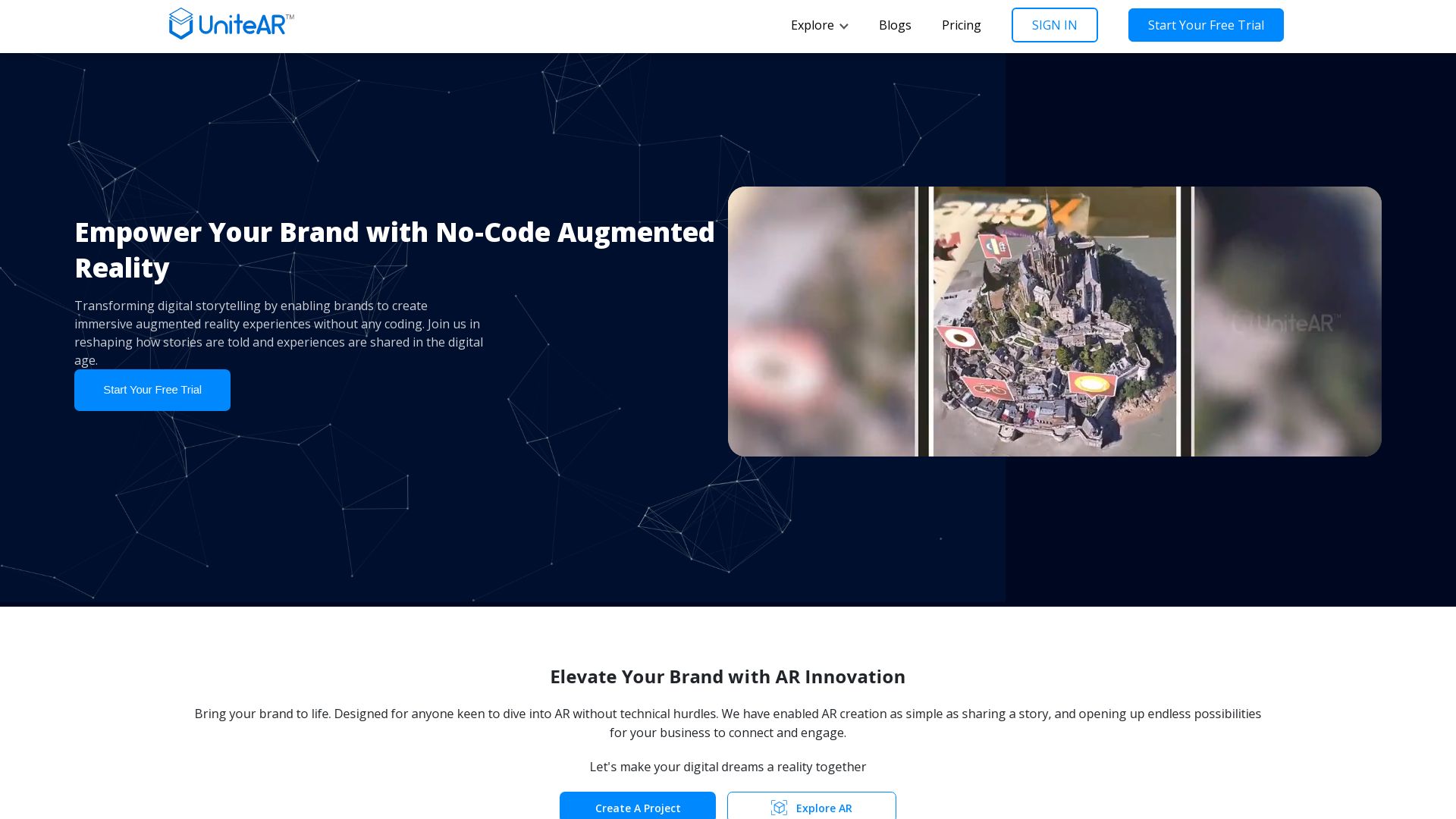
Unleash the riveting revolution of augmented reality with UniteAR. It’s a free, no-coding-required platform developed by iBoson Innovations, specializing in creating engrossing and immersive AR experiences.
UniteAR Top Features
- Over 100 3D models, sculpting a vivid AR gallery.
- An enticing mix of 3D models, 360-degree content, videos, animated gifs and image slideshows.
- Enable unique interactions such as playing audio, visiting websites, making calls, or sending emails just by tapping the 3D models.
- Effortless record and share abilities to capture your AR explorations.
- XRmeet feature lends digital assistance using AR, paving a path for easier technical troubleshooting.
| Platform Compatibility | Language Options |
|---|---|
| iOS 11.1 or later, MacOS 11.0 or later, Ideal for devices like iPhone, iPad, iPod touch, Mac with Apple M1 chip or later | English, Arabic, French, Portuguese, Spanish |
| UniteAR SaaS Platform | Privacy Assurances |
UniteAR Limitations
- Available primarily in the business category, possibly limiting scope for individuals or non-profit users.
- Currently optimized for Apple devices, potentially limiting reach to non-Apple users.
UniteAR Pricing
Nothing beats the magic of free! UniteAR can be downloaded and used free of charge, with options for in-app purchases. Plus, there’s a bonus – a free trial is also available!
UniteAR Use Cases
Educators
From creating intriguing virtual scenarios to supplement lessons, to providing dynamic learning tools, UniteAR can redefine classroom experiences while providing students an interactive learning environment.
Creators
For the talent-laden creators, UniteAR serves as an enchanting canvas that breaks the boundaries of reality. Digital storytelling or Art exhibitions? The cosmos of AR is at your command!
Enterprises
Exploring ways to captivate your audience or elevate your marketing gameplans? UniteAR is your AR genie, giving an edge to your strategies by designing delightful experiences for your customers.
BUNDLAR
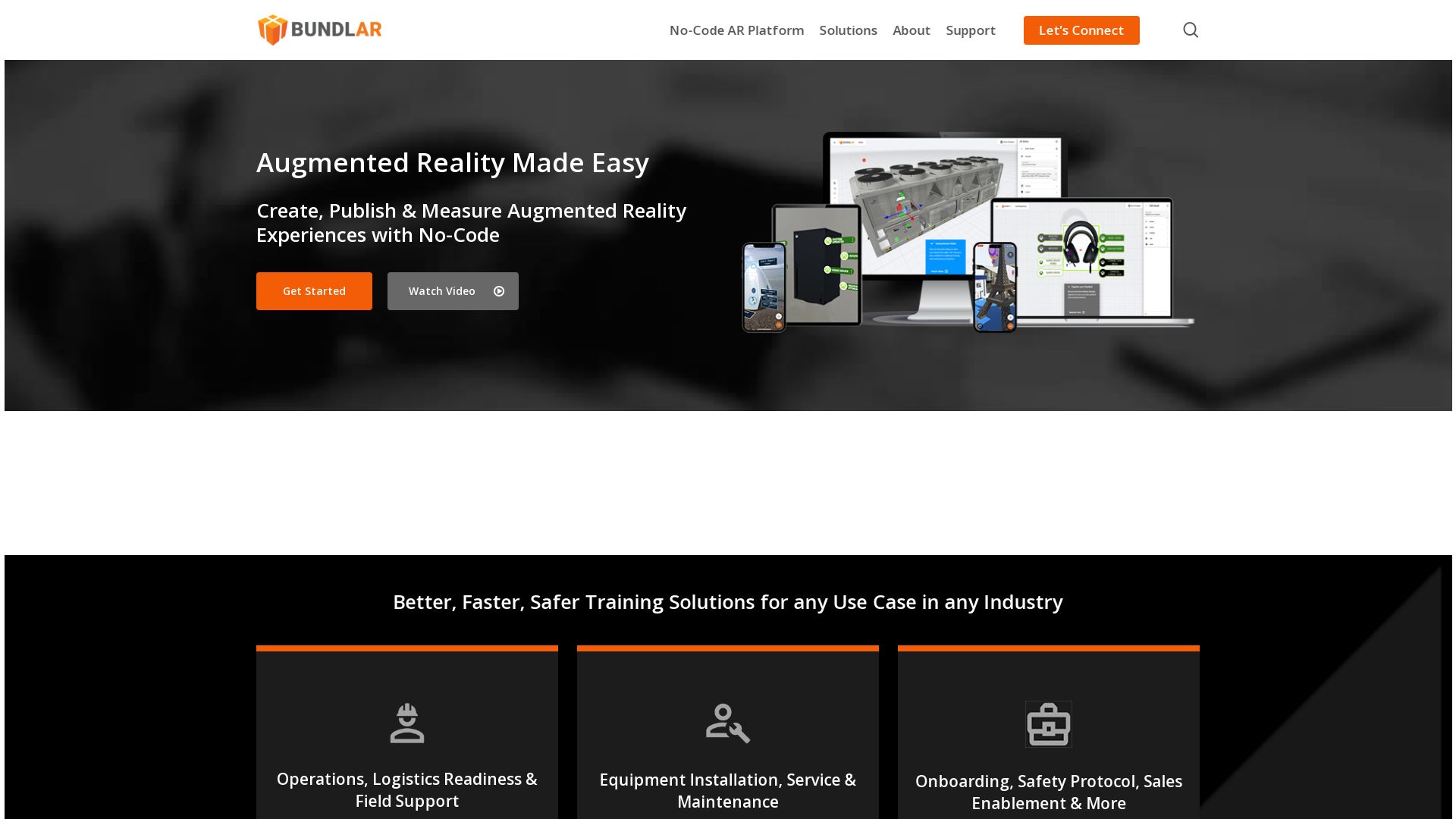
BUNDLAR is an innovative Augmented Reality platform providing a no-code solution for AR experience creation, publication, and measurement. Applications cater to a broad range of individual and enterprise needs, from operations to sales enablement. With a responsive CMS and reliable cloud ‘bundling’, BUNDLAR aims to democratize AR creation.
BUNDLAR Best Features
- No-code platform for AR experiences creation
- Intuitive CMS with drag-and-drop feature
- Easy user access via the BUNDLAR app, with no headset required.
- Analytics dashboard to track interactions, optimize performance, measure ROI
- Integration with well-established third-party software
- Customizable user experience for projects
| AR Experience Editing | Privacy Practices |
|---|---|
| BUNDLAR facilitates editing of AR experiences after initial deployment | Data collection abides by strict privacy regulations, recording location, contact info, identifiers, usage data etc. |
| Supported by cloud ‘bundling’ | Requires iOS 12.0 or later for compatability |
BUNDLAR Limitations
- Limited to iOS users with iOS 12.0 or later
- Dependent on strong internet access for optimal use of cloud ‘bundling’
BUNDLAR Use Cases
Use case 1: Equipment Installation
BUNDLAR can offer interactive and immersive AR experiences for equipment installation, enhancing efficiency and understanding.
Use case 2: Onboarding
Augmented Reality provides an engaging and demonstrative way to onboard new employees, making BUNDLAR an ideal tool.
Use case 3: Sales Enablement
Sales teams can leverage BUNDLAR’s AR capabilities to present immersive product demos, enhancing client interaction and sales potential.
Wikitude

Born in 2008 in Salzburg, Austria, Wikitude began with location-based AR experiences delivered via the World Browser App. Today, it has evolved into a comprehensive Software Development Kit (SDK) that spans image recognition, 3D model rendering, video overlay, SLAM, and location-based AR.
Top Features of Wikitude
- High-end image tracking and cylinder tracking for targeted AR experiences.
- Multiple object tracking for complex AR scenarios.
- Integration with external native AR frameworks for flexible, robust solutions.
- Accurate location-based AR leveraging a user’s position, direction, and device accelerometers.
| Feature | Description |
|---|---|
| Positional Tracking | Combines with Object and Image Tracking for a richer AR experience. |
| Support for AR Foundation from Unity | Enables seamless object visualization within the Unity Editor. |
| Recognition and Tracking | Capable of recognizing and tracking multiple 2D images, even in challenging environments. |
Limitations of Wikitude
- Debate around the accuracy of location-based AR features, hinging on GPS, compass, and motion sensor readings.
- Requires advanced AR or Unity expertise for maximum SDK utilization.
Use Cases for Wikitude
Expert AR Developers
Wikitude provides advanced AR features and platform flexibility, ideal for sophisticated AR projects requiring high-performing solutions.
Location-based Applications
Leveraging location data (GPS/Wi-Fi), compass, and accelerometers, Wikitude is perfectly suited for creating engaging location-based AR experiences.
3D Modeling
With its powerful 3D model rendering capabilities, Wikitude enables the creation of realistic and immersive AR experiences.
Vuforia
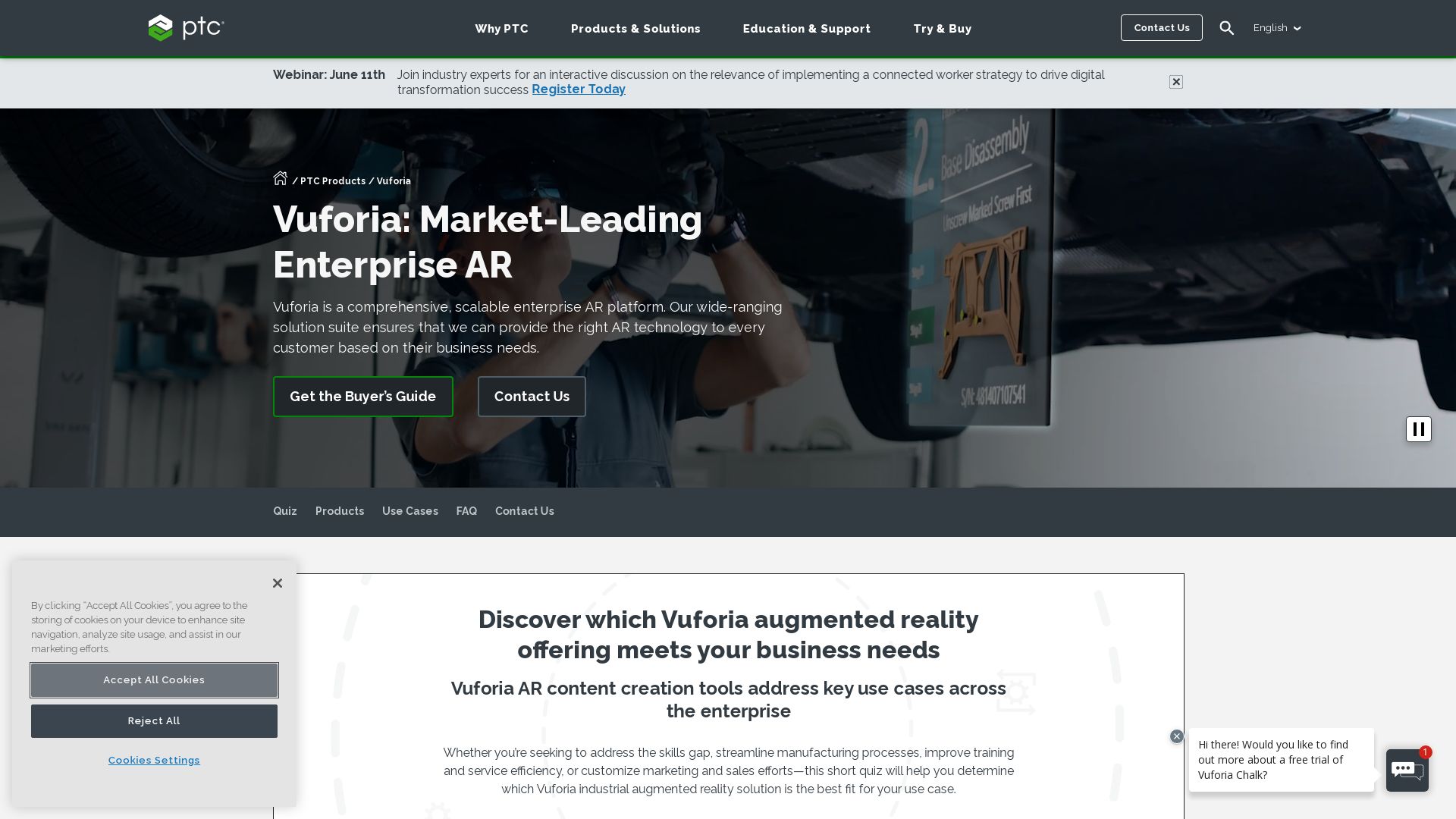
Unleashing the power of Augmented Reality, Vuforia, an AR software development kit (SDK), serves as a beacon for AR developers globally. Created by Qualcomm, and later acquired by PTC Inc., it positions itself at the intersection of computer vision technology and object recognition, fostering the building of dynamic AR applications.
Vuforia Top Features
- Support for 2D/3D target types, revolutionizing AR creation.
- Markerless Image Targets and 3D Model Targets for interactive AR experiences.
- Localized occlusion detection, enhancing realism in AR applications.
- Supports AR headsets/glasses including industry giants like HoloLens, Magic Leap, and Vuzix M400.
- The ability to overlay real-time data on real-world objects for a comprehensive AR experience.
- Exclusive Vuforia engine cloud add-ons embracing wider AR capabilities.
- Dynamic recognition and targeting options for a broader scope in AR applications.
| Feature | Description |
|---|---|
| VuMark | A shift from conventional QR codes, supports custom design and multiple formats. |
| Cloud Recognition Database | Facilitates remote target image storage for extensive AR application versatility. |
| Compatibility | Sprawling ecosystem compatible with Windows 10, iOS, Android devices; and AR headsets/glasses. |
Vuforia Downsides
- Virtual Buttons feature is deprecated, signifying it will be removed in future versions.
- Cloud add-on overages leave developers with additional costs ($0.01/ Cloud recognition).
Vuforia Pricing
Vuforia offers a free development license for learning and non-commercial projects along with a Basic Plan and a Premium Plan for wider features and publishing scope. Both plans offer optional Cloud and Cloud Plus add-ons for enhanced Cloud Recognition but comes with additional costs for overages.
Vuforia Use Cases
Use case 1: Interactive Campaigns
Thanks to features like real-time data overlay and localized occlusion detection, Vuforia powers innovative interactive campaigns to capacious audiences.
Use case 2: 3D Product Demonstrations
Vuforia’s dynamic recognition and unique 3D model targets make it the perfect intersection of technology to build powerfully evocative 3D product demonstrations.
Use case 3: AR Digital Twin
Vuforia shines in creating AR digital twins, strengthening the bond between physical and digital spaces while providing real-time insights on object interactions.
Blippar
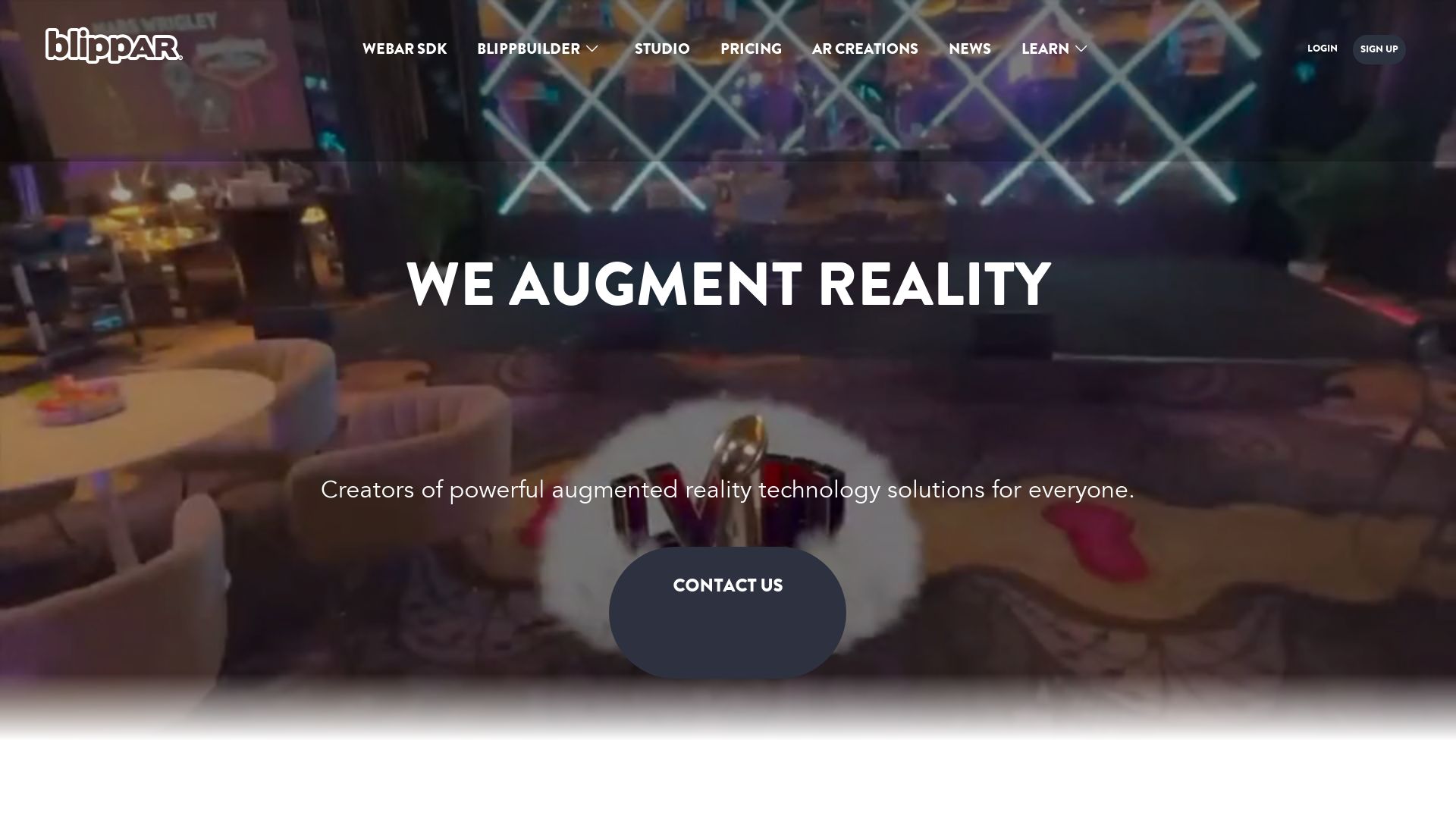
Blippar, the UK’s first tech unicorn, is known for its proficiency in AR content creation and publishing. Steered by the hands of CEO Faisal Galaria, Blippar was initially established in 2011 to provide smartphone-based AR tech solutions for advertisers. Despite a few financial setbacks in 2018, Blippar has bounced back stronger, transitioning from creating AR experiences to becoming a SaaS platform for AR creation.
Blippar Top Features
- AR Content Creation: Offering an integrated design studio for AR content development.
- Visual Search Engine: Launched in 2016, it utilises AR tech for intuitive visual searches.
- Recognition APIs: Developed facial and car recognition APIs for businesses.
- Blippbuilder: A free-to-use no-code AR creation tool.
| Feature | Explanation |
|---|---|
| Partnerships | Blippar has forged strategic partnerships with major brands like Porsche, Jaguar Land Rover, PepsiCo, etc., affirming its industry prowess. |
| Pivot | Blippar has successfully transitioned its focus from creating AR experiences to setting up a robust SaaS platform for AR creation. |
Blippar Limitations
- Past financial instability that led to insolvency proceedings in 2018.
- Blippbuilder, though free, might not be comprehensive enough for more complex AR projects.
Blippar Pricing
Blippar’s pricing details are not provided in the summary. However, it does offer a free no-code AR creation tool, the Blippbuilder.
Blippar Use Cases
Use case 1: Advertisers
Blippar’s initial forte – smartphone-based AR solutions for advertisers can create engaging ad campaigns like the AR game developed for Cadbury.
Use case 2: Corporates
Through Blippar’s recognition APIs, corporates can leverage facial recognition for security purposes or car recognition for auto sales.
Use case 3: Content Creators and Designers
With Blippar’s integrated design studio and Blippbuilder tool, creators and designers can easily develop and publish AR content.
Logan Bellbrook
Content writer @ Aircada with a knack for nature & AR/VR/XR. Blogging the intersection of tech & terrain.



